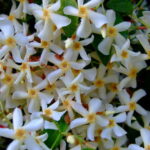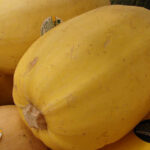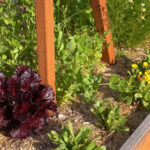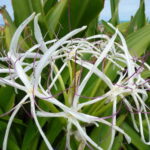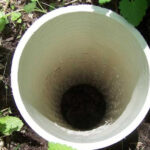One of the most hated pests is the dreaded squash bug. Much like many common pests in the warmth of the spring and summer growing season, they suck plant juices from your beloved squash vines. They do a lot of damage and proliferate on plants too. That’s why is so important to identify squash bugs and take them out.
What’s crazy is that squash bugs tend to attack winter squash varieties in the spring just as much as summer squash. They not only attack zucchini but are commonly found on lots of other cucurbits. That’s why we’ve dedicated a portion of this piece to their most common host plants.
There’s also a bit of confusion surrounding the difference between squash bugs and the squash vine borer. Both similarly lay eggs, but how you should act is different depending on what insect we’re talking about.
So let’s discuss how to identify squash bugs in the garden, and determine how home gardeners can treat and prevent squash bugs altogether.
Squash Bug Overview
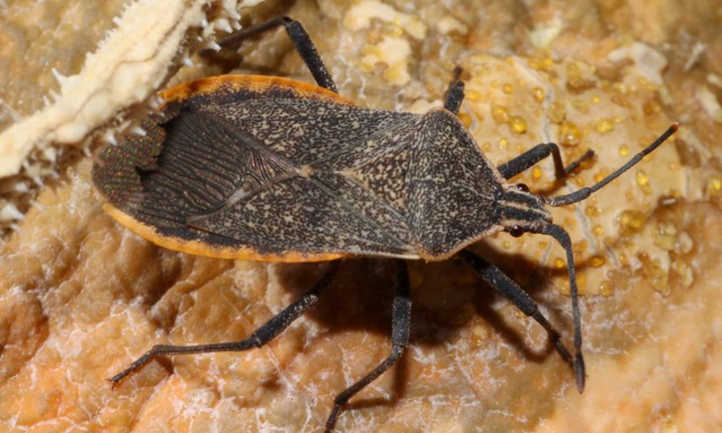
| Common Name(s) | Squash bug |
| Scientific Name(s) | Anasa tristis |
| Family | Coreidae |
| Origin | Central America, the United States, southern Canada |
| Plants Affected | Cucurbits such as squash, zucchini, pumpkin, gourds, watermelon, and cucumber |
| Common Remedies | Hand-picking insects, horticultural oil, neem oil, insecticidal soap, diatomaceous earth, pyrethrin, floating row covers |
What Are Squash Bugs?
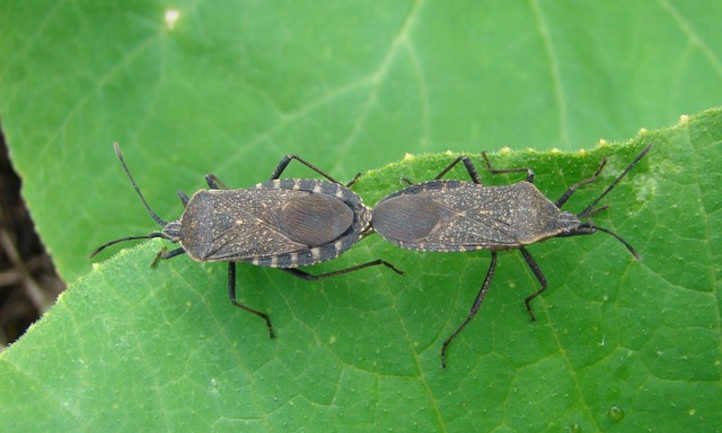
Squash bugs are scientifically known as Anasa tristis. Just like their insect pest counterparts, they feed on the plant juices of squash plants, sucking sap through a proboscis that sits under their bodies. They target many members of the cucurbit family and can damage plants to the point of total collapse.
Adult squash bugs are greyish-brown to black insects that are about ½ inch long. Squash bugs are members of the true bug family, which includes shield bugs and stink bugs. The squash bug takes on that shield shape, just like its family members. At first glance, they may look completely black, but there are slight variations in the hue on their abdomens. When they are disturbed, they put off a slight aroma that is likened to cilantro, and sometimes sulfur, ammonia, or rancid meat.
Squash bug eggs are very small and oval-shaped, sized at 1/16th of an inch. They are bronze to rusty red and are laid in groups of 15 to 40. You may find squash bug eggs on the undersides of leaves or the stems of your squash vines. Squash bug nymphs look like chalky white or pale green spiders with dark black legs. Their size sits between the tiny squash bug egg and the size of the adult squash bug.
Important Distinctions
While the common name, squash bug is shared by multiple insect pests that consume squash plants, this article focuses on Anasa tristis, a relative of stink bugs. This article does not cover the dreaded squash vine borer, a moth that lays eggs that hatch highly damaging larvae. While there is some overlap between the two in terms of how to practice effective squash bug control, they are different insects.
Another common confusion comes from the identification of cucumber beetles as squash bugs. These beetles are not in the same insect family and have a much more striking appearance displaying shiny yellow shells with black spots. While some treatment methods for cucumber beetles are the same as those for squash bugs, their appearance is where they diverge.
Squash Bug Host Plants
Most squash bugs seek out pumpkin and squash vines to lay their eggs because these plants support the life cycle of squash bugs most effectively in comparison to other cucurbits. Overall, they will attack almost any cucurbit vines, though. Recent studies show that while squash bugs prefer squash and pumpkin, they also enjoy feasting on cucumber, watermelon, and musk melon (also known as cantaloupe). However, they are cucurbit generalists and will adapt to almost any vine in the squash family that is available to them. They tend to attack cucurbits that are native to the Americas, especially winter squash, like Hubbard. Heirloom and old squash vines are less susceptible to squash bug feeding.
Life Cycle of Squash Bugs

The life cycle of squash bugs begins with eggs, progresses to nymphal stages, and finally, adulthood. Adult squash bugs lay eggs when the weather warms up, somewhere between April and early June in most areas. At that point, the adult bugs emerge from their overwintering sites and fly to their plant hosts. Depending on the climate, an adult female can lay anywhere from one to three egg masses at a time. Each egg cluster numbers eighteen eggs on average. These sit on the undersides of squash leaves.
Seven to nine days later, the squash bug eggs hatch into the first of five nymphal stages, called instars. In the first of these, the hatched squash bug nymphs are green and appear hairy, and they’re about a tenth of an inch in size. For each subsequent instar, the young squash bugs grow, gradually become darker, and lose their hairy spines. By the fifth instar, nymph squash bugs are just a little smaller than an adult. It’s at this point they start to form wing pads and become a dark gray. They eventually turn brown or dark brown as they become adult squash bugs. The entire process from hatching to adulthood takes about 33 days.
Identifying Squash Bug Damage
As a squash bug sucks the juices from squash plants, it injects toxic saliva into the feeding area. The first sign of squash bug damage is dark stippling or yellow spots on the leaves and stems of squash plants. Eventually, these stippled marks turn yellow, and brown. While this process goes on, plants begin to take on droopy leaves that resemble symptoms of bacterial wilt.
As the fruit of squash plants forms on the vine, an unchecked squash bug population may turn to them for sustenance. In this case, the damage comes in the form of lesions that can cause sudden wilting of fruit if the entire plant is stressed enough. The final stage of squash bug damage symptoms is the death of the cucurbit plants they’re consuming.
Squash Bugs as Disease Vectors
It’s very important to manage squash bugs in your garden because they carry a serious disease that can spread to your otherwise healthy squash plants. The disease in question is a bacterial infection by the pathogen Serratia marcescens which causes cucurbit yellow vine disease (CYVD). Squash bugs inject toxins into plant matter as they feed, and infected bugs transfer this disease, causing sudden yellowing and collapse of vines in mid-summer. The disease remains in the bodies of squash bugs who overwinter in the garden and emerge to feed and unintentionally cause further disease spread.
Controlling Squash Bugs
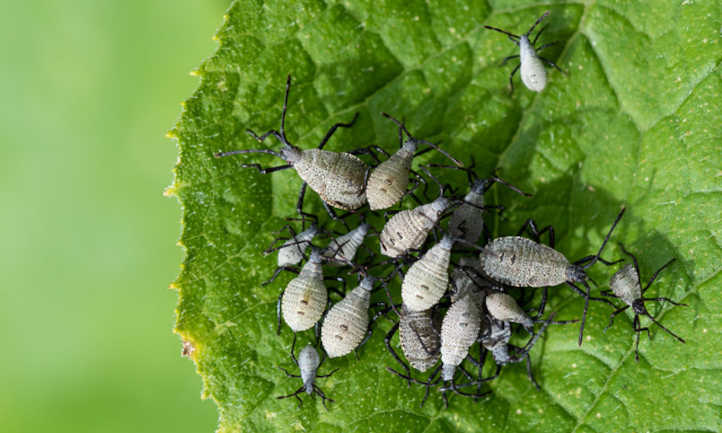
Squash bugs may not be destructive in just one season, but they can do a lot of damage if their population is allowed to get out of control in just a couple of seasons. Let’s talk about ways to kill squash bugs, prevent squash bugs, or get rid of squash bugs in your garden. Use multiple forms of control in an integrated pest management strategy for the best results.
Cultural Control
Early detection is a huge part of squash bug control. Look for egg masses, young bugs, and adult bugs throughout the growing season. Find both small nymphal spider-like bugs with black legs and adult squash bugs that are dark brown and have bodies that look like a stink bug. Handpick both adults and nymph bugs from the plants.
Use a wet butter knife to flick bugs from the plants into soapy water that is dish-soap-based. Eggs will be clustered on the undersides of leaves and the stems of squash plants. Remove these with your fingernail and drown them in dish soap as well.
Plant resistant varieties of squash plants in your garden, like butternut, royal acorn, and sweet cheese. While these won’t completely keep squash bugs away, they’re less likely to attack them. Plant these in your garden alongside less resistant varieties that are easy to grow, like zucchini. Then remove the infested plants and drop the bugs into water mixed with dish soap.
Trellis your cucurbit plants. You will often see squash bugs found in the sprawling parts of vines rather than in vertical areas. They are less likely to hide in an upward trellis than they are in a squash mound or patch.
When you’re done harvesting the fruit for the season, remove plants quickly to eliminate the habitat where squash bugs lay more eggs in your garden. Either till it under, or compost it well. This keeps your garden free of overwintering bugs. If you’re unsure if a vine has eggs on it, destroy it.
Finally, if you have seen squash bugs in your garden, take a few boards and lay them around the base of your plants. As squash bugs seek shelter at night, they creep under the boards. In the early morning pick up each board and hand-pick the bugs out of the garden or knock them off the board and drown them in a bucket of soapy water.
Biological Removal of Squash Bugs
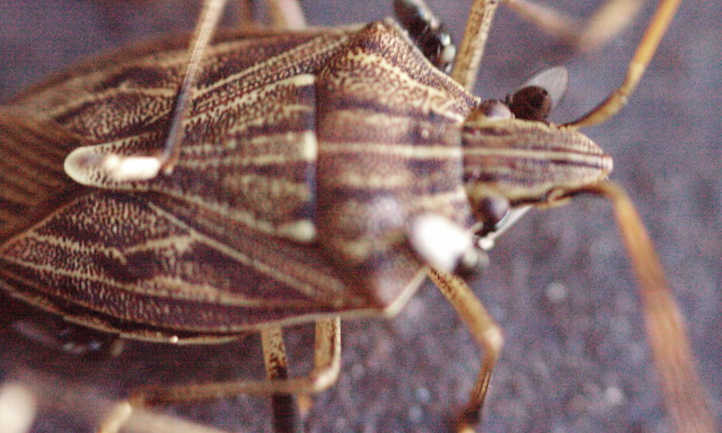
The most important of the beneficial insects that help you get rid of squash bugs is the parasitic tachinid fly, Trichopoda pennipes. This fly lays 100 some-odd eggs on the undersides of nymph and adult squash bugs. When the eggs hatch, the maggot bores into the squash bug body and feasts upon its insides, emerging from between the segments of the bug’s body.
In the process of emerging, these maggots manage to kill squash bugs, helping you get rid of squash bugs in your garden. It is most effective when it parasitizes nymph bugs, rather than adults.
Instead of simply introducing this species into your garden, include plants that attract it to the space. Tachinid flies enjoy cilantro, dill, fennel, parsley, Queen Ann’s Lace, aster, chamomile, feverfew, ox-eye daisy, and Shasta daisy. Weeds such as sweet clover attract these flies too.
When you flick adult squash bugs into soapy water, check to ensure they don’t have elongated white tachinid eggs on their undersides. If they do, leave them, and kill squash bugs that aren’t hosts.
Other insects also use squash bugs to raise their young. The Hymenoptera order of parasitic wasps, especially the families Encyrtidae and Scelionidae, will help you get rid of squash bugs and many other garden insects such as caterpillars and beetles. Many of the plants that host tachinid flies also host these garden friends.
Insecticidal Removal of Squash Bugs
When it comes to pesticides, insecticides that are organic are more effective on nymphs than they are for adult squash bugs. That’s because egg masses and bugs hang out near the vine crown and are difficult to reach with sprays.
The most effective organic sprays are horticultural oil, canola oil, and neem oil. Spray these in the early morning before the sun rises or at dusk when there is minimum bee activity. Remember to spray underneath the leaves, and coat the plant with a light mist. Reapply sprays every 7 to 10 days until the problem subsides.
Insecticidal soap is one way to kill a squash bug. Ensure you make direct contact with the bug’s body to use insecticidal soap effectively. Reapply insecticidal soap every 7 to 10 business days when you see nymphs or adults on your plants.
Diatomaceous earth on the plant leaves controls nymphs effectively. Dust plants again after it rains. Note that this method can damage beneficial insects if you’re not careful to avoid dusting flowers.
Pyrethrins are an effective organic control when they’re sprayed a couple of weeks or more before a harvest. They remain on the plant longer than neem and can be reapplied in intervals of 2 to 3 weeks at a time. They’re also especially useful for young seedlings because of the need for a few weeks before harvest. Do not spray pyrethrins if you’re within a couple of weeks before the harvest. They should not be consumed.
While there are multiple chemical insecticides recommended to kill squash bugs, they also damage and prevent visitation by beneficial insects, namely pollinators. If you decide to hand pollinate the squash flowers and you’re ok with preventing pollination of nearby plants, you can use these. It’s easier to avoid them, though.
Preventing Squash Bugs
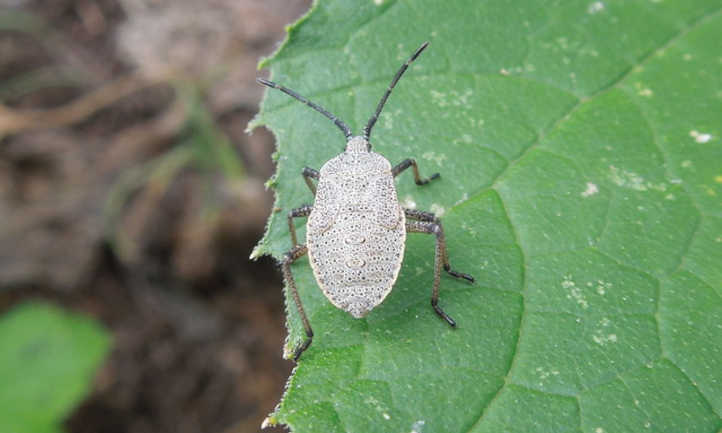
Floating row covers are the best way to prevent squash bugs. They keep adults out in their breeding season in the early summer. This prevents feeding and subsequent egg-laying of new generations of squash bugs to come. Ensure the row cover is adequately secured to the ground to prevent any infiltration.
When you remove your squash plant that began fruiting in early summer, remove plant debris to prevent the transfer of any remaining eggs to next season’s garden. Treat squash bugs found in the dead leaves as well. Along with planting resistant cultivars of cucurbits in your garden, you can delay planting until the early months of summer. By this time, squash bugs have already found their host plants and laid their eggs.
Frequently Asked Questions
Q: How do you keep squash bugs away naturally?
A: All of the methods we mentioned above in the control section are effective means of natural control. However, if pesticides aren’t your thing, look at the cultural and biological methods of control, and the prevention methods listed in this article.
Q: Are stink bugs and squash bugs the same?
A: They aren’t. A stink bug won’t eat your squash plants. Squash bugs do emit a stench when crushed like stink bugs, but they’re not the same.
Q: What will repel squash bugs?
A: Floating row covers are the best prevention. Diatomaceous earth repels them also.
Q: What attracts squash bugs?
A: Cucurbits and their decaying debris host these bugs and their eggs.
Q: Do any plants repel squash bugs?
A: Yes! Catmint tends to repel squash bugs. Dill also is considered to be effective, as are nasturtium and tansy. And finally, both peppermint and spearmint are considered effective natural repellents, but be careful with these, as mint plants also have the tendency to invade and take over if not controlled!
Q: Are squash bugs harmful to humans?
A: While the saliva of squash bugs can be toxic to plants, and can carry cucurbit yellow vine disease, their saliva is not harmful to humans, nor is any other part of the bug. However, they can and do stink when disturbed or squashed. This means that if you have a sensitive nose, you might find the aroma offensive.
Q: Do praying mantises eat squash bugs?
A: They do, but praying mantises also eat ladybugs and other beneficial insects. If you have mantises in your garden already, they may assist you with the squash bug population somewhat, especially if you catch them and move them to where they’re most needed.


